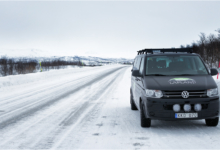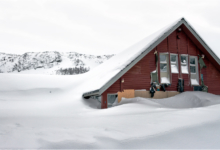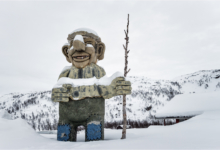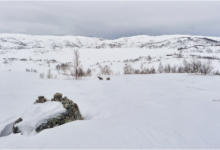Abisko is a small village in the north of Sweden, about 55 miles NW of Kiruna. It is located on Lake Tornetrask, and the local geography of the lake and surrounding mountains creates a localised ‘blue hole’ – a condition where the sky over the lake can be clear, even when the surrounding mountains are covered by cloud. This, together with the absence of light pollution, means that Abisko is one of the best locations for viewing the Aurora Borealis. Numerous tour operators therefore feature Abisko as a winter destination for viewing the Northern Lights. Our holiday included an evening on the shores of the lake with some professional photographers to offer guidance, and we were fortunate that this coincided with a spectacular aurora display.
Our other activities at Abisko included a trip to Narvik on the Norwegian coast – famous as a battle location during WWII, and a gentle walk through the Abisko National Park, out onto the lake ice.
Narvik Excursion
The town of Narvik was established at the end of the 19th Century as the terminus of the Ofoten railway, bringing iron ore from Kiruna in Sweden. The town is also famous as a WWII battle location. In spring 1940, Narvik and the surrounding area was the site of both naval and land battles between Allied and German forces due to the strategic importance of the railway and iron ore that it carried. Although the Allied forces were largely victorious, they quickly withdrew from Narvik after the fall of France due to the need to re-deploy troops elsewhere.
The day of our trip to Narvik was very overcast, which meant we missed out on much of the scenery along the way. We made a few stops to take a look at a reindeer herd, to visit an abandoned shopping site half buried in snow but still featuring a large troll, and at the border with Norway. Close to Narvik we also stopped to take some photographs of the Rombaksfjord. It was interesting to see the Ofoten railway cutting across the hillside. This railway was constructed at the end of the 19th century to transport iron ore from Kiruna to the ice free Norwegian coast, and was a significant engineering feat. Today, the railway boasts the world’s most powerful electric locomotives, capable of pulling 68 wagons each loaded with 100 Tonnes of iron ore across the mountainous terrain, and the track is designed to take the highest axle load in Europe.
Aurora At Abisko
The evening after the Narvik trip was scheduled as a photography evening, hoping to catch the aurora. After the bad weather during the day, we were sceptical we would see anything, but the skies cleared and the aurora turned up right on cue! There were a couple of professional photographers leading our group, and they took us to a location on the shores of Lake Abisco. From there we had views of the mountains and ski slopes above the village, and it was in this direction that the aurora first appeared. Gradually the display built up, until there were vivid swirls over the mountains. A little later, and fainter aurora also began to appear over the lake.
Our photographer guides also had a tent set up in the forest to be used in the event of bad weather and although we did not use it, it provided an interesting foreground subject for the aurora. Overall the display lasted about 2 hours and we were delighted that we had ticked off a major item on our bucket list.
After the evening however I had some disappointment however as I had left a skylight filter on my lens throughout the evening. Due to the very narrow frequency range of the aurora light, the light bouncing between the filter and lens produces circular interference fringes – concentric rings of light and dark bends. Fortunately both Carol and I were shooting images, so we still had a selection to choose from, but the lesson is clear – remove any filters when shooting the aurora!
Abisko Lake
Our last day at Abisko was a free day, so together with some other guests staying at the hotel we took a leisurely stroll through some woods and out onto the frozen Lake Abisko. From the lake there were open views towards Lapporten – an impressive U shaped valley to the south of Abisko. On the way back, we came across some climbers practicing ice climbing in the Abisko gorge.
That evening after dinner, part of our holiday itinerary was to take the chairlift to the top of the Abisko ski slopes to visit the mountain restaurant, with the hope of viewing the aurora from the top of the mountain. Unfortunately the night was cloudy, so nothing to see, but it was a little strange taking the chair lift at night in the bitter cold.









































